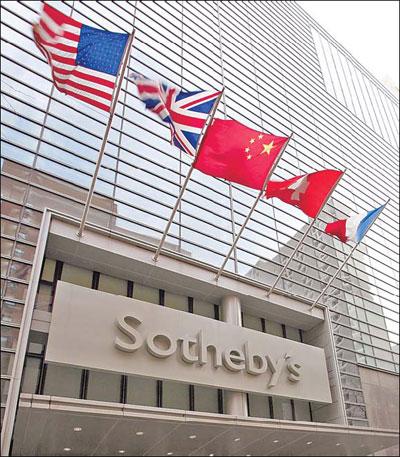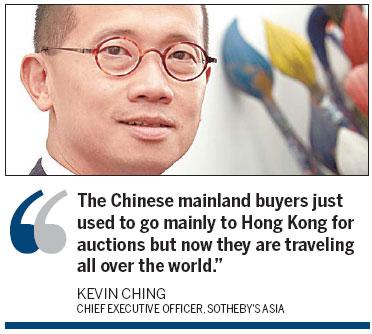
The Chinese flag billows outside Sotheby's New York headquarters. Chinese mainland buyers are having a dramatic affect on the Western art market. Wherever the auctioneers have a sale of Chinese art, whether in New York, Paris or London, the rooms are becoming packed with people from China. [Provided to China Daily]
Chinese buyers flock to auction houses to buy works by Western artists including Warhol and PicassoLONDON - Kevin Ching, chief executive officer for Sotheby's in Asia, believes Chinese mainland buyers are having a dramatic effect on the Western art market.
This was symbolized last month when the international auctioneers hoisted the Chinese flag outside its New York headquarters.
"The Chinese mainland buyers just used to go mainly to Hong Kong for auctions but now they are traveling all over the world," he said.
Ching, a 53-year-old Hong Kong Chinese was speaking in Sotheby's offices in New Bond Street in London just a day after the Fine Chinese Ceramics and Works of Art sale, where the saleroom was packed with people from the Chinese mainland.
"We had our Chinese sale here yesterday (May 12) and the room was full of people from Asia, especially China. Wherever you go now - London, New York or Paris - when you have a sale of Chinese art, the room will be packed with people from China," he said.
The China flag flying in New York is in recognition of the business generated by the Chinese for the auction house.
Chinese mainland buyers made up around half of last year's sales in Asia for Sotheby's compared with just 15 percent when Ching joined the firm in 2006. On the back of this Hong Kong has become the company's third most important sales center after New York and London.
It was at Ching's suggestion the China flag should be flown over the York Avenue building.
"A lot of Chinese kept coming to the building and asked why we didn't raise the Chinese flag. When it was to happen I was asked to come over to sing the China anthem," he said.
The main international focus is now on China's new rich buying Western art, particularly impressionists. It is believed a number of leading works at a Sotheby's impressionist auction in New York earlier this month went to mainland Chinese buyers.
Ching said the big purchases by Chinese collectors of impressionist art have really begun to happen over recent months.
"It has taken off over the last year. Previously, there were a lot of inquiries and underbidding but no real purchases. The fighting to secure the works started at the end of 2008 or the beginning of 2009," he said.
"We thought originally our first major buyers would be from developed areas such as Beijing or Shanghai but that is actually not the case with many coming from other provinces."
Ching, a trained lawyer who is also a jade collector, said the art buying of the Chinese is beginning to be more aggressive than that of the Japanese in the 1980s.

"If you see how far the Chinese have come in the past 10 years, that is perhaps more impressive than what the Japanese did," he said.
Ching said that the interest in Western art has been something of an evolutionary process.
"They started off buying Chinese paintings and ceramics but have been gradually buying in other categories, particularly red wine, especially from Bordeaux and Burgundy, watches and jewelry such as big quality diamonds," he said.
"In terms of purchasing art, those who have been buying Chinese contemporary paintings have felt more comfortable in moving to buy impressionist. They like nice colorful pictures. At this juncture they are more attracted to this sort of painting than Western contemporary art. I think that requires a greater understanding of Western culture before you can appreciate it," he said.
He said Chinese buyers were also turned off by traditional Western art.
"I think some of the old master and religious paintings do not appeal to the Chinese," he said.
Ching said it was not always easy to persuade Chinese investors to buy Western art.
"I have three or four key clients who could easily spend 100 million yuan every time we have a sale. While they might be happy to spend 30 million yuan on a small little porcelain vase, they might be reluctant to buy a fairly decent impressionist painting for the same money. There is always a perception they don't know enough," he said.
He added many of the Chinese buyers have made their personal fortunes in mainstream businesses such as real estate and finance.
"Some of the new money they represent is 15 to 20 years old so in a sense it is new old money in the China context," he said.
Ching dismissed any suggestion that China's billionaire art investors were merely speculators looking to make quick profits.
"Many of the Chinese buyers are wealthy enough to make large sums of money overnight in business dealings and so the idea they would spend $3 million or $4 million on a painting merely to speculate is not really credible. It is just peanuts for them," he said.
He said many of them buy the art to display in their offices rather than their homes.
"Many of them have huge offices and they like to display it there, talk about it and share it with other people. They care about how their workplace looks," he said.
He said some were also interested in building private museums so that the public would be able to enjoy the art as well.
"Very few of our other buyers want to share their collections with the public but we are finding a lot of our Chinese buyers are in the process of planning museums to house their collections," he said.
Ching said Sotheby's intended to increasingly aim its main sales in New York and London at Asian buyers.
It will be exhibiting some of the works prior to major sales not just in Hong Kong but in key locations in the Chinese mainland as well.
"We have been doing this anyway but knowing the growing interest by the Chinese on the mainland we will be bringing more highlights to Hong Kong and, hopefully, the mainland in the future," he said.
Sotheby's has also increased the Chinese content on its website and some of its podcasts also have Chinese subtitles. "We also have Chinese client managers and business development people who speak Chinese who can look after our key clients," he said.





